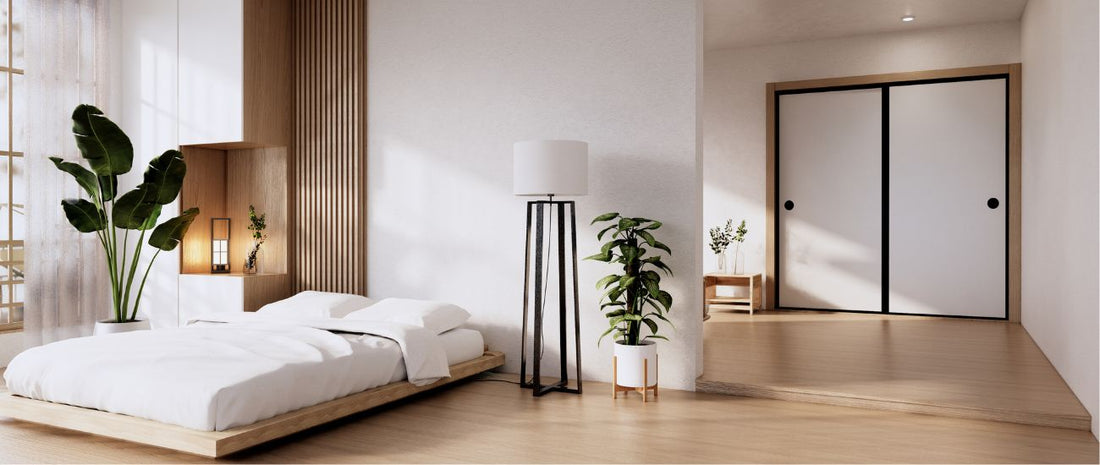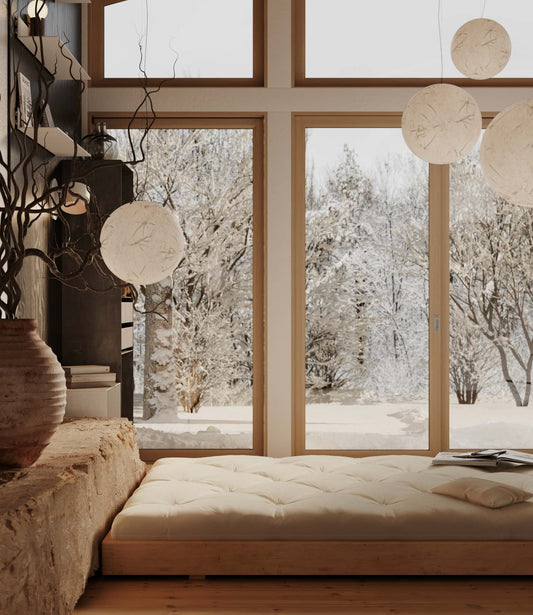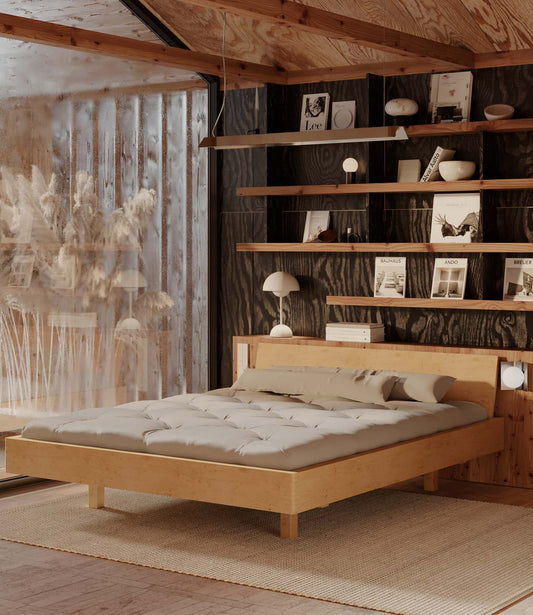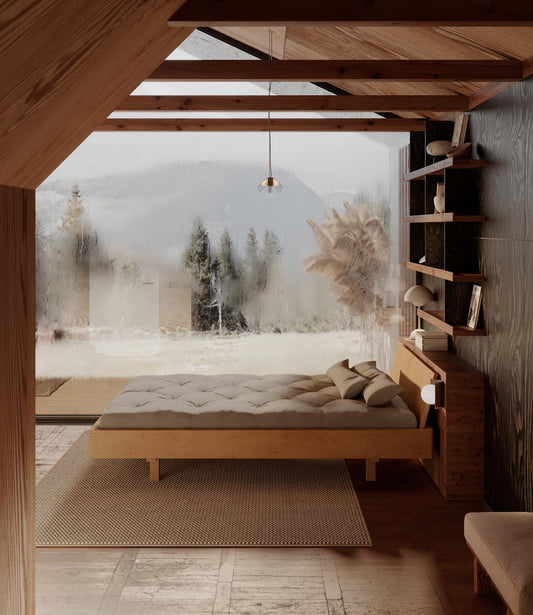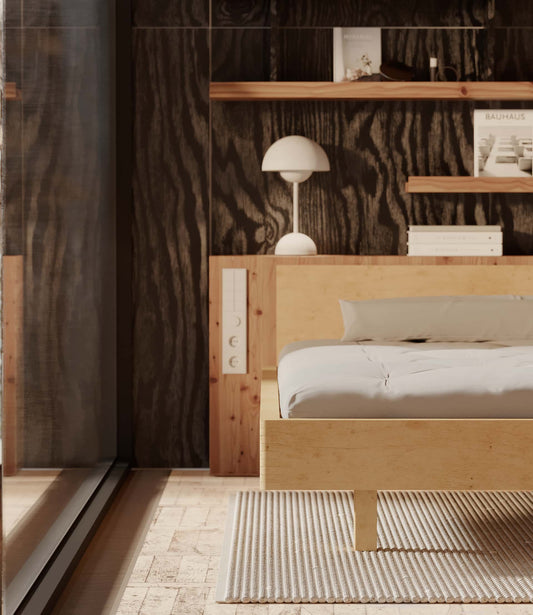A futon bed combines traditional Japanese sleeping style with modern comfort. But what exactly is a futon bed and why could it be the perfect choice for your bedroom? In this article, you'll learn everything about the characteristics, advantages, and various models of futon beds.
The Most Important Points at a Glance
- Futon beds combine traditional Japanese sleeping style with modern comfort by offering a low mattress on a slatted frame, often made of natural materials like solid wood.
- Futon beds offer numerous advantages such as minimalist design, a healthy sleep climate through natural materials, and space-saving construction, making them particularly attractive for small rooms.
- When buying a futon bed, factors such as stability, size, materials, and the choice of mattress are crucial for sleeping comfort; additionally, various models offer extra functions like storage space and flexibility in room design.
What is a Futon Bed?
A futon bed is more than just a sleeping surface; it's a combination of traditional Japanese sleeping style and modern comfort. Unlike the classic bed, which is often high and equipped with soft mattresses, futon beds combine the idea of sleeping closer to the ground with a purist look and high comfort.
Futons, as they are known in Japan, symbolize sleeping closer to the earth and thus closer to nature. These sleeping places consist of a mattress that lies directly on the floor and is rolled up during the day. Modern futon beds, however, have evolved and offer a mattress on a low slatted frame, often made of solid wood.
From Japanese Futon to Modern Futon Bed
The journey from traditional Japanese futon to modern futon bed is fascinating. Originally, futons in Japan were spread out on rice straw mats at night and rolled up again in the morning. These mattresses consisted of several layers, including latex core and natural cotton.
Over time, futon beds have evolved to meet Western comfort demands. The mats on the floor gave way to low bed frames with a mattress elevated on a slatted frame. This combination of traditional and modern sleeping style offers the best of both worlds.

The Construction of a Futon Bed
A typical futon bed is characterized by the following features:
- low construction
- use of natural materials
- beds often made of solid wood or wickerwork
- mattress consists of cotton, wool, and foam
The low frame of a futon bed, often without headboard and feet, contributes to the traditional Japanese style. Various wood beam thicknesses and connections provide an authentic appearance and adapt to different interior styles.
Advantages of a Futon Bed
Futon beds offer numerous advantages that make them an attractive choice for modern bedrooms. Here are some of them:
- Their minimalist design and use of natural materials contribute to a healthy sleep climate.
- They allow for unique design in the bedroom.
- They offer a larger lying surface as the classic separation of individual mattresses is omitted.
Another advantage is the combination of traditional Japanese sleeping style and European comfort, such as a slatted frame. Low beds offer a pleasant sleeping feeling and ensure a relaxed rest phase. These beds are particularly popular among younger people who appreciate minimalist design and European sleeping comfort.
Natural Materials and Their Benefits
The use of natural materials in futon beds offers numerous advantages. Futon mattresses often consist of cotton, latex core, and coconut, which significantly improves sleeping comfort. These materials are not only environmentally friendly but also particularly adaptable to the body, leading to a better sleeping experience.
Coconut and natural latex are particularly valued materials for futon mattresses as they are breathable and durable. A cotton futon is soft and breathable, however less durable than other mattress types.

Space-Saving Design
Futon beds are ideal for small rooms as they offer a space-saving design. Their low sleeping height is reminiscent of traditional Japanese sleeping places and allows for flexible use of space. A futon bed can be rolled up during the day to use the space for other activities.
Some futon beds are equipped with storage options, such as drawers or bed boxes, which provide additional space for bedding and other items. This makes them particularly practical for small apartments and multifunctional rooms.
Selection Criteria When Buying a Futon Bed
Several factors play an important role when buying a futon bed. Besides design, stability, size, materials, and the choice of mattress are crucial for sleeping comfort. The bed height is particularly relevant for older people or those with back problems.
Additional elements such as choosing the right slatted frame and the right mattress are also important. The following subsections provide you with detailed information on these selection criteria and their evaluation.
Size and Dimensions
Futon beds are available in various sizes to meet individual needs and room conditions. The most common sizes are 160x200 cm, 140x200 cm, and 180x200 cm. For single persons or smaller rooms, futon beds with dimensions of 140x200 cm are well suited.
Couples who prefer a lot of space in bed should opt for the size 180x200 cm. Super King Size futon beds offer ultimate luxury and measure about 180 cm x 200 cm.
Materials and Wood Types
Choosing the right material and wood type is crucial for the quality and longevity of a futon bed. Hardwoods such as oak, maple, or pine are particularly popular and provide a robust foundation for the bed.
Futon beds are available in various wood types, such as:
- Alder
- Beech
- Pine
- Oak
The delivery of these beds is usually quick and reliable.
This variety allows the bed to be adapted to personal taste and bedroom decor.

Firmness Level and Mattress Choice
The firmness level and choice of mattress are crucial for optimal sleeping comfort. Futon mattresses are available in various firmness levels, with back sleepers particularly benefiting from firm mattresses.
Various mattress types are suitable for futon beds, including foam futon mattresses and spring mattresses. Allergy sufferers and asthmatics should pay particular attention to the materials used when selecting futon mattresses.
Various Designs and Models
Futon beds come in numerous designs and models that can be adapted to personal taste and room design. From low beds with or without headboard to models with legs or box shapes, futon beds offer diverse options.
These beds are available in various sizes, colors, and stain colors, so you can find the perfect model for your bedroom. Some futon beds can also be used as a sofa, making them particularly versatile. The right color can enhance the room and create a pleasant atmosphere.
With or Without Headboard
A futon bed with a headboard can provide additional comfort by serving as a backrest. This is particularly practical for reading or watching TV in bed. Simple headboard designs provide straight structures in the bedroom and fit a minimalist interior design style.
Futon beds without a headboard are ideal for rooms with sloped ceilings as they take up less space. Personal taste and available space determine whether a futon bed with or without a headboard is chosen.
Futon Beds with Storage Space
Futon beds with storage space offer practical solutions for additional space in the bedroom. Models with drawers or integrated bed boxes are particularly useful for storing bedding and other items. In an online shop, you will find a large selection of such futon beds.
Some futon beds have shelf compartments at the head or foot end, providing space for books or magazines. Beds with legs can be equipped with under-bed drawers to create additional storage space.
Care and Maintenance of a Futon Bed
The care and maintenance of a futon bed is crucial for its longevity and hygiene. Regular turning and rotating of the futon mattress prevents sagging and promotes even wear. A futon cover protects the mattress from stains and should be washed regularly.
Futon beds should be aired regularly to avoid moisture accumulation. A mat or slatted frame under the futon can further promote ventilation and reduce moisture.
Cleaning the Futon Mattress
Cleaning the futon mattress is simple and effective. Regular vacuuming removes loose dirt, hair, and dust. Stains should be treated immediately to remove them more easily, ideally with a slightly damp cloth and mild cleaning agent.
Baking soda can be used to remove odors from the mattress. A futon mattress should only be taken outdoors in good weather to air it out in the fresh air and reduce moisture.
Care of the Wooden Frame
The care of the wooden frame of a futon bed is equally important. The wooden frame should be dusted regularly to keep it clean and free of dirt. A damp cloth can be used to clean the wooden frame without damaging it.
To remove stains or stubborn dirt on the wooden frame, a slightly damp cloth can be used. An annual treatment of the wooden frame with care oil can protect the wood and increase its longevity.
Tips for Designing Your Bedroom with a Futon Bed
A futon bed creates a special atmosphere in the bedroom by reminiscing Asian models and creating a cozy ambiance. A minimalist design can be well created with a futon bed. Combine it with minimalist furniture for a stylish interior.
A tatami as a base for the futon bed can improve the ambiance of the bedroom and set additional visual accents. A futon bed can also be used multifunctionally, e.g., as a seat for meditation, as a substitute for a sofa, or as an alternative sleeping place.
Summary
Futon beds offer a unique combination of traditional Japanese sleeping style and modern comfort. They are ideal for anyone who appreciates minimalist design and natural materials. Their space-saving properties make them particularly suitable for small rooms and flexible usage possibilities.
If you're looking for a bed that is both stylish and functional, then a futon bed is the perfect choice. Let yourself be inspired by the variety of models and designs and find the futon bed that best suits you and your bedroom.
Frequently Asked Questions
What is a futon bed?
A futon bed is a combination of traditional Japanese sleeping style and modern comfort. It consists of a mattress on a low slatted frame and is often made of natural materials such as solid wood. It provides a pleasant sleeping environment and fits well with a minimalist living style.
What advantages do futon beds offer?
Futon beds offer numerous advantages, such as minimalist design, the use of natural materials, and space-saving properties that enable a pleasant sleeping feeling. They are a good choice for a modern and comfortable bedroom.
What sizes are available for futon beds?
Futon beds are available in various sizes, from 90x200 cm for single persons up to 180x200 cm for couples. Super King Size models offer additional luxury.
How do I care for a futon bed?
To care for a futon bed, it's important to regularly turn, vacuum, and air the mattress. Additionally, the wooden frame should be regularly dusted and treated with care oil.
Are futon beds suitable for small rooms?
Yes, futon beds are an excellent choice for small rooms due to their space-saving design and often available storage options.
